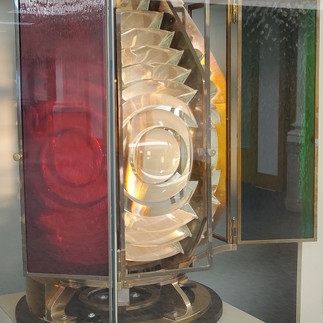Demise of a Sister Light
- Kewaunee Lighthouse
- Dec 15, 2022
- 3 min read
THE LOSS of the WAUKEGAN LIGHTHOUSE
By Jake Heffernan
(Left to right) Holland, MI; Waukegan, IL; Kewaunee, WI
The lighthouse marking the piers of Waukegan, Illinois, 40 miles north of Chicago, was the first of these three "sister" lighthouses built for Lake Michigan, as well as the first to have a fog signal added. It is also the only of the three to meet an untimely end.
In 1899, a circular tower was built at the end of the Waukegan pier, replacing an older, shore-based lighthouse.
The tower then had a fog signal building added in 1906, providing compressed air for a fog siren. The light was produced by a 4th order Fresnel lens, exhibiting a characteristic of fixed white for 20 seconds, with a series of four red flashes at five-second intervals.
Comparing the construction of the Waukegan lighthouse to the other two at Holland, MI and Kewaunee, WI, the tower at Waukegan was essentially partially embedded in the lakeward face of the Fog Signal building, allowing the tower to be accessed from both the first and second stories of the fog signal building. The other two lighthouses featured a detached, open framed tower that was connected to the fog signal building by a small corridor extending from the 2nd story. (See photos at top of article)
In later years, Holland and Kewaunee would have the external towers removed and reused, while square towers were built out of the lakeward gable of the Fog Signal Buildings. Holland had this modification in 1936, while Kewaunee had it at the end of the 1930 season. The lower levels of the lighthouses are framed in steel and clad in brick inside and steel outside. The upper level of the lighthouses are framed in wood.
The Waukegan Lighthouse served a relatively quiet career, supervising passenger and package steamers in and out of the harbor. Minor modifications were made to the station in order to stay up to date with navigation technology. In 1939, city electricity was ran out to the lighthouse, eliminating the oil lamp. In 1962 or 1963, the Fresnel Lens and fog sirens were removed and replaced with a pair of much simpler Tyfon horns and a far less delicate beacon.
The end came early in the morning of June 1, 1967.
Two enlisted Coast Guard men were assigned to the station at the time, with the third assigned position vacant. At 2am on the morning of June 1st, the man on watch noticed the pierhead light had gone out, noting this in the station logbook.

Minutes later, he noticed the unthinkable – the pierhead light was on fire!

Despite the efforts of the Coast Guard and the Fire Department, by the time the light station crew observed morning colors, the building was a total loss.

The wood-framed gables of the second floor were destroyed, as was the lantern room. The Coast Guard drawing below shows the rough outline of the damage to the building, as well as the changes to be made.
A note in the lower right spells the end – “All of damaged machinery bldg and lantern house to be removed.”


The tower was sealed and a simple green beacon placed in place of the missing lantern. Today, many don’t even know of the existence of this Lost Light, but it’s clear there is definitely something missing at the end of the Waukegan, Illinois pier.

After removal from the tower in 1962, the 4th Order Fresnel lens was placed on display in the Milwaukee Public Library in 1974. It remains on display at the library today. (Photos provided by MPL)
Written using information by historians Terry Pepper and Kraig Anderson and historic research conducted by Jake Heffernan.
Logbook entries and building plans from the National Archives.

























Comments